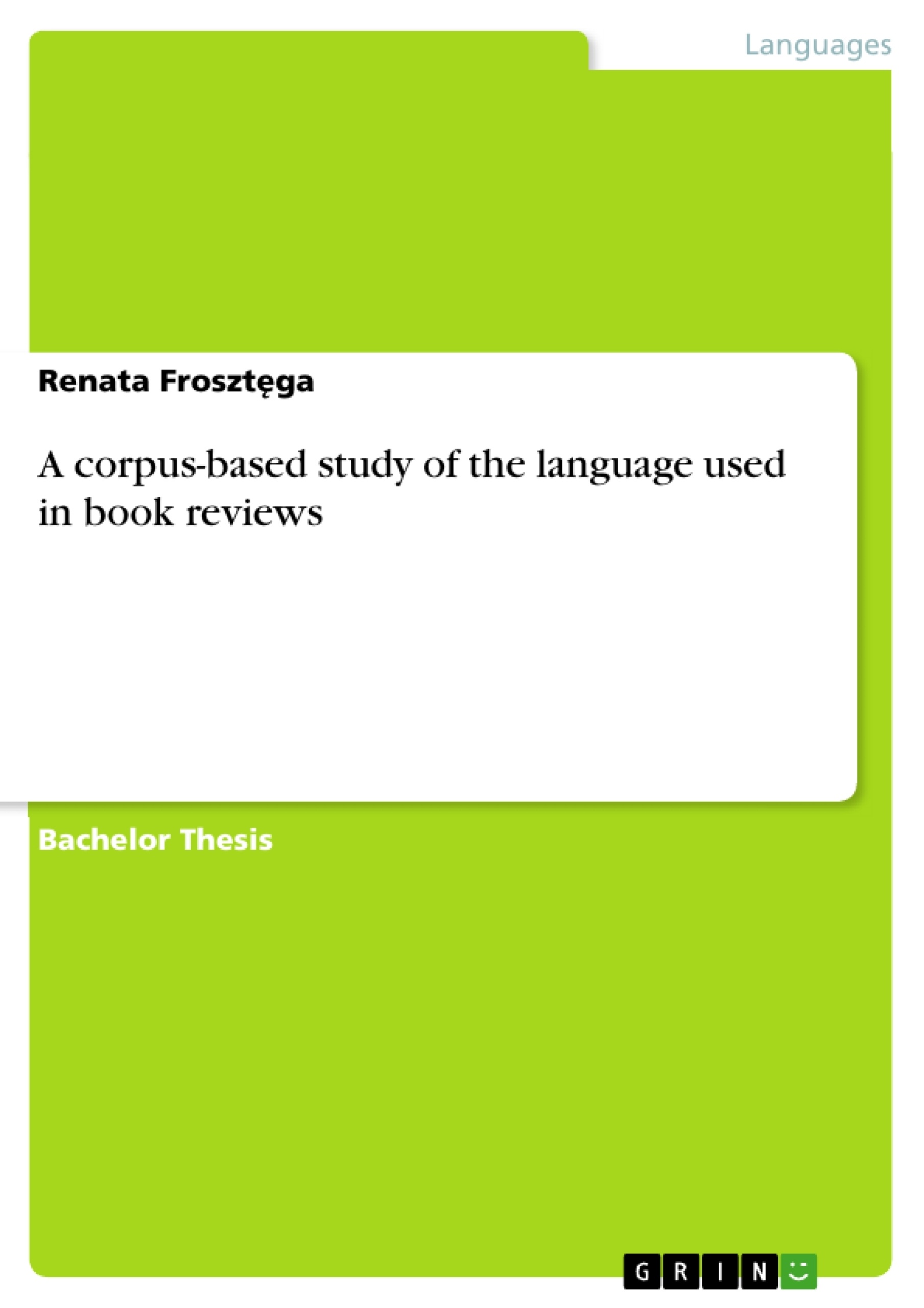The aim of this thesis is to discuss certain aspects of the language of book reviews, stressing the importance and indispensability of a corpus-based approach in any study of this type. The thesis is to show that the register of book reviewing is a specialized language, characterized by specific vocabulary. By this is meant that there exist some words and phrases which tend to be used more frequently here than in other registers, or that some words have a special, narrowed meaning.
For this purpose the researcher has compiled her own corpus of book reviews in an electronic form, which provides the foundation for the analysis. This collection of written language samples is referred to as the Do-It-Yourself Book Review Corpus (henceforth, DIY BRC). As regards the source of materials, the reviews come from the websites of popular quality newspapers.
In order to ensure the research a relatively high reliability, the linguistic data needs to be as large as possible. Therefore, my corpus (DIY BRC) totals approximately 115 000 words derived from as many as 166 book reviews. The mean sample size is between 660 and 982 words.
Inhaltsverzeichnis (Table of Contents)
- INTRODUCTION
- CHAPTER ONE
- 1 THE THEORETICAL BACKGROUND OF THE CORPUS LINGUISTICS
- 1.1 Corpus linguistics - historical sketch and scope of interest
- 1.1.1 The definition and area of interest
- 1.1.2 The historical background of corpus linguistics
- 1.2 The idea of corpus
- 1.2.1 Defining the term
- 1.2.2 Major electronic corpora
- 1.2.2.1 The COBUILD Bank of English
- 1.2.2.2 The British National Corpus
- 1.2.2.3 Other important corpora of English
- 1.2.2.4 Corpora for special purposes
- 1.2.3 Issues in compilation and corpus design
- 1.2.3.1 Criteria for corpus design
- 1.2.3.2 Size
- 1.2.3.3 Representativeness
- 1.2.4 Basic procedures used in corpus analysis
- 1.2.4.1 Frequency list
- 1.2.4.2 Concordances
- CHAPTER TWO
- 2 INFORMATION CONNECTED WITH THE GENRE OF REVIEWS
- 2.1 Main characteristic of the press
- 2.1.1 Press genres
- 2.2 Main characteristic of reviews
- 2.2.1 Book reviews
- 2.2.1.1 Book review vocabulary
- CHAPTER THREE
- 3 A CORPUS-BASED RESEARCH INTO BOOKS' REVIEWS
- 3.1 Compilation of the DIY Book Review Corpus – basic information
- 3.2 Frequency of words
- 3.2.1 General versus specialized vocabulary
- 3.2.2 Findings concerning the frequency list of book review terms
- 3.3 Concordance analyses of selected terms
- 3.3.1 The noun reader
- 3.3.2 The noun book
- 3.3.3 The noun novel
- 3.3.4 The noun plot
- 3.3.5 The noun character
- 3.3.6 The noun story
- 3.3.7 Synonyms writer and author
- The specialized language of book reviews.
- The importance of corpus linguistics in analyzing language use.
- The frequency of words and phrases in book reviews.
- The contextual meanings of words and phrases in book reviews.
- The construction of a corpus of book reviews (DIY BRC).
Zielsetzung und Themenschwerpunkte (Objectives and Key Themes)
This thesis aims to explore specific aspects of the language used in book reviews, emphasizing the crucial role of corpus-based approaches in such studies. The research seeks to demonstrate that the register of book reviewing is a specialized language characterized by specific vocabulary. This suggests that certain words and phrases are employed more frequently within this genre than in other contexts, or that specific words take on narrower meanings. The research focuses on a corpus of book reviews compiled by the author, referred to as the Do-It-Yourself Book Review Corpus (DIY BRC).
Zusammenfassung der Kapitel (Chapter Summaries)
Chapter one provides a theoretical framework for the study, focusing on fundamental aspects of corpus linguistics. It discusses the definition and area of interest of corpus linguistics, a brief historical sketch of corpus-based studies, the definition and various classifications of corpora, factors considered during the compilation of a corpus, and basic procedures and tools used by researchers for processing linguistic data.
Chapter two delves into the nature of book reviews as a press genre. The author explores the main characteristics of the press, classification of press genres, key features of different review types, and characteristics of book reviews. The chapter concludes with a glossary of book review terms, intuitively created by the researcher to compare her word selection with the results of the corpus analysis conducted in the following chapter.
Chapter three focuses on a corpus-based study of the language of book reviews gathered in the DIY BRC. The research utilizes WordSmith Tools, specifically frequency lists and concordances. The chapter presents basic information about the DIY BRC, followed by an examination of the frequency of words and their use in the corpus through concordance analysis. The author demonstrates how concordance analysis can identify contextual similarities and differences between particular synonyms.
Schlüsselwörter (Keywords)
The main keywords and focus topics of this thesis include corpus linguistics, book reviews, specialized language, vocabulary, frequency lists, concordances, DIY BRC, press genre, and linguistic analysis.
- Citar trabajo
- Renata Frosztęga (Autor), 2014, A corpus-based study of the language used in book reviews, Múnich, GRIN Verlag, https://www.grin.com/document/337151



